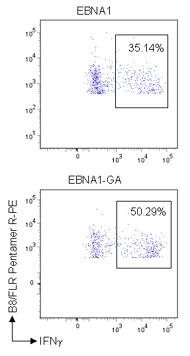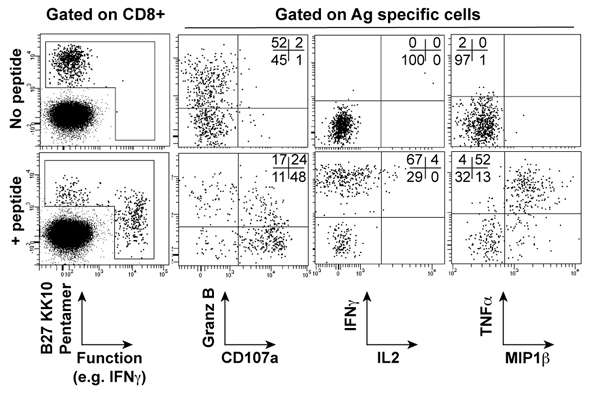Your basket is currently empty!
Pentamers-and-Intracellular
Case Study:
Costaining for Pro5® Pentamer and IFN gamma illustrates differential presentation of CD8+ T cell epitopes
Tellam, J. et al. (2006). Influence of translation efficiency of homologous viral proteins on the endogenous presentation of CD8+ T cell epitopes J. Exp. Med. 204(3): 525-32. [PubMedID: 17312009]
 Judy Tellam, from the group of Professor Rajiv Khanna, at the Queensland Institute of Medical Research, and Mark Fogg from Harvard Medical School used a Pro5® MHC Class I Pentamer and intracellular cytokine staining in their study to show how protein translation affects the molecular dynamics of antigen presentation.
Judy Tellam, from the group of Professor Rajiv Khanna, at the Queensland Institute of Medical Research, and Mark Fogg from Harvard Medical School used a Pro5® MHC Class I Pentamer and intracellular cytokine staining in their study to show how protein translation affects the molecular dynamics of antigen presentation.
 The study compared the immune responses to EBV encoded nuclear antigen, EBNA1, with and without its internal Gly-Ala repeat sequence. These two versions of the protein have significantly different protein translation efficiencies. A combination of the B*08:01/FLRGRAYGL Pro5® Pentamer and costaining for interferon gamma expression was used to assess the activation of FLR-specific T cells that were stimulated with lymphoblastoid cell lines (LCLs) expressing the two different EBNA1 proteins.
The study compared the immune responses to EBV encoded nuclear antigen, EBNA1, with and without its internal Gly-Ala repeat sequence. These two versions of the protein have significantly different protein translation efficiencies. A combination of the B*08:01/FLRGRAYGL Pro5® Pentamer and costaining for interferon gamma expression was used to assess the activation of FLR-specific T cells that were stimulated with lymphoblastoid cell lines (LCLs) expressing the two different EBNA1 proteins.
A significant increase in Pentamer-positive and interferon gamma-expressing T cells was observed when EBV EBNA1-specific T cells were stimulated with LCLs that were transduced with an adenoviral construct carrying the EBNA1 antigen without the Gly-Ala repeat (EBNA1-GA) compared to those stimulated with LCLs transduced with the full-length EBNA1.
Case Study:
Study using HIV-specific Pro5® MHC Class I Pentamers with intracellular cytokine staining provides useful data for the development of T cell vaccine
Almeida, J.R. et al. (2007). Superior control of HIV-1 replication by CD8+ T cells is reflected by their avidity, polyfunctionality, and clonal turnover. J Experimental Medicine 204: 2473-2485. [PubMedID:17893201]
Almeida et al. carried out an in-depth analysis of the MHC Class I B*27:05/KRWIILGLNK (KK10) HIV-1 epitope. Previous studies have shown that the presence of B27-KK10 epitope-specific T cells confers some protection against progression of the disease in HIV-positive individuals.
Pro5® Pentamers specific to several HIV-1 epitopes were used to identify the antigen-specific cells, which were then further analyzed by flow cytometry to determine their phenotypic characteristics. Additionally, the capacity of B27-KK10-specific CD8+ T cells to produce effector cytokines and to release cytotoxic factors upon antigenic stimulation was assessed with a B*27:05/KRWIILGLNK (KK10)-specific Pentamer and intracellular cytokine staining in order to provide a picture of CD8+ T cell functional quality.
Interestingly, the B27/KK10 CD8+ T cell population showed a significantly higher proportion of cells producing effector cytokines and cytotoxic factors compared with other HIV-specific CD8+ T cells, suggesting that these cells are highly functional. This polyfunctional capability may contribute in part to the protective characteristics and better disease control associated with this epitope. The authors commented that combined data from the study might aid in the development of successful T cell vaccines.

A representative example of simultaneous multifunctional assessment of B27-KK10-specific CD8+ T cells using nine-colour flow cytometry. Cells were stimulated for 6 h in the presence of cognate peptide before intracellular cytokine staining. Percentages of cells in the different quadrants are shown. Plots are gated on CD3+CD8+ cells. Copyright Rockefeller University Press 2007.
Publications citing the use of Pro5® MHC Pentamers in combination with ICS
Almeida, J. et al. (2007). Superior control of HIV-1 replication by CD8+ T cells is reflected by their avidity, polyfunctionality, and clonal turnover. J. Exp. Med. 204: 2473-85. [PubMedID: 17893201]
B*27:05/KRWIILGLNK (HIV-1 gag p24)
A*03:01/QVPLRPMTYK (HIV-1 nef)
A*03:01/RLRPGGKKK (HIV-1 gag p17)
B*07:02/GPGMKARVL (HIV-1 gag)
Bailey, JR. et al. (2008). Transmission of human immunodeficiency virus type I from a patient who developed AIDS to an elite suppressor. J Virol. 82: 7395-7410. [PubMedID: 18495769]
B*27:05/KRWIILGLNK (HIV-1 gag p24)
Caccamo, N. et al. (2006). Phenotypical and functional analysis of memory and effector human CD8 T cells specific for mycobacterial antigens. J. Immunol. 177: 1780-1785. [PubMedID: 16849488]
A*02:01/GLPVEYLQV (Mycobacterium bovis antigen 85-A)
Casado, JG. et al. (2009) Correlation of effector function with phenotype and cell division after in vitro differentiation of naive MART-1-specific CD8+ T cells. International Immunolgy. 21: 53-62. [PubMedID: 19050104]
A*02:01/ELAGIGILTV (MelanA/MART-1)
Fousteri, G. et al. (2009). CD103 is dispensable for anti-viral immunity and autoimmunity in a mouse model of virally-induced autoimmune diabetes. J. Autoimmunity. 32: 70-77. [PubMedID: 19162441]
H-2Db/KAVYNFATC (LCMV gp33)
H-2Db/FQPQNGQFI (LCMV NP)
Gandhi, M.K. et al. (2007). Galectin-1 mediated suppression of EBV-specific T-cell immunity in classical Hodgkin-s lymphoma. Blood 110: 1326-9. [PubMedID: 17438085]
A*02:01/CLGGLLTMV (EBV LMP-2)
Grolleau-Julius, A. et al. (2008). Impaired dendritic cell function in aging leads to defective antitumor immunity. Cancer Res. 68: 6341-6349. [PubMedID: 18676859]
H-2Kb/SIINFEKL (Ovalbumin)
Karlsson, H. et al. (2008). Mesenchymal stem cells exert differential effects on alloantigen and virus-specific T cell responses. Blood 112: 532-541. PubMedID: 18445691]
A*02:01/NLVPMVATV (HCMV pp65)
B*07:02/RPHERNGFTVL (HCMV pp65)
B*07:02/TPRVTGGGAM(HCMV pp65)
A*02:01/GLCTLVAML (EBV BMLF-1)
B*07:02/RPPIFIRRL (EBV EBNA-3A)
B*08:01/RAKFKQLL (EBV BZLF-1)
Radford, KJ. et al. (2006). CD11c+ blood dendritic cells induce antigen-specific cytotoxic T lymphocytes with similar efficiency compared to monocyte-derived dendritic cells despite higher levels of MHC class I expression. J Immunother. 29: 596-605. [PubMedID: 17063122]
A*02:01/ELAGIGILTV (MelanA/MART-1)
A*02:01/GILGFVFTL (Influenza MP)
Rawson, P.M. et al. (2007). Cross-presentation of caspase-cleaved apoptotic self antigens in HIV infection. Nat. Med. 13: 1431-1439. [PubMedID: 18026114]
A*02:01/LLQDSVDFSL (Vimentin)
A*02:01/QLFNHTMFI (Non-muscle myosin)
A*02:01/VLMIKALEL (Non-muscle myosin)
A*02:01/FLGMESCGI (Actin)
Smith, C et al. (2009). Acquisition of polyfunctionality by Epstein-Barr virus-specific CD8+ T cells correlates with increased resistance to galectin-1 mediated suppression. J Virol. 83: 6192-6198. [PubMedID: 19357166]
A*02:01/CLGGLLTMV (EBV LMP-2)
B*08:01/FLRGRAYGL (EBV EBNA-3A)
Suneetha, PV. et al. (2009) Effect of peptide pools on effector functions of antigen-specific CD8+ T cells. J Immunol. Methods 342: 33-48. [PubMedID: 19135447]
A*02:01/GILGFVFTL (Influenza MP)
A*02:01/NLVPMVATV (CMV pp65)
A*02:01/GLCTLVAML (EBV BMLF-1)
A*02:01/CINGVCWTV (HCV NS3)
Tellam, J. et al. (2007). Influence of translation efficiency of homologous viral proteins on the endogenous presentation of CD8+ T cell epitopes. J. Exp. Med. 204: 525-532. [PubMedID: 17312009]
B*08:01/FLRGRAYGL (EBV EBNA-3A 193-201)
Tellam, J. et al. (2008). Regulation of protein translation through mRNA structure influences MHC class I loading and T cell recognition. PNAS. 105: 9319-9324. [PubMedID: 18591662]
B*35:08/HPVGEADYFEY (EBV EBNA1407-417)
Yagi, H. et al. (2006). Induction of therapeutically relevant cytotoxic T lymphocytes in humans by percutaneous peptide immunization.Cancer. Res. 66: 10136-10144. [PubMedID: 17047078]
A*02:01/EYLQLVFGI (MAGE-2)
A*02:01/IMPKAGLLI (MAGE-3)
Zhong, J. et al. (2008). Induction of pluripotent protective immunity following immunisation with a chimeric vaccine against human cytomegalovirus. PLoS one. 3:e3256. [PubMedID: 18806877]
A*02:01/NLVPMVATV (CMV pp65)
A*01:01/VTEHDTLLY (CMV pp50)
